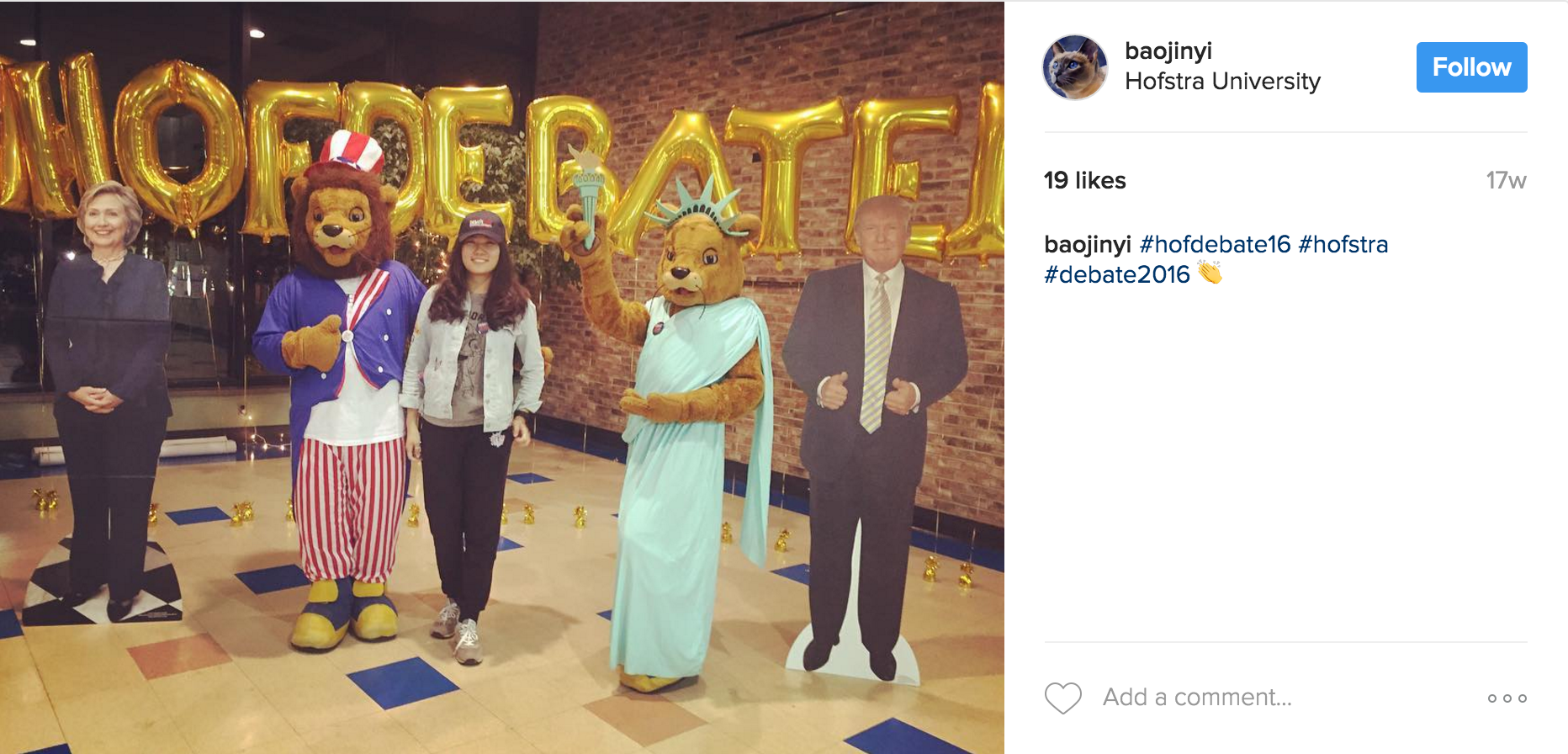
Hofstra University hosted the first debate of the 2016 election cycle on September 26, becoming the only university ever to host three consecutive presidential debates. Originally designated an alternate site, Hofstra was pressed into service in July – giving us only nine weeks to prepare for an event for which campuses normally have 18 months. Our goal, as it had been in the previous two election cycles, was to promote civic engagement among our students, to give them opportunities to learn about issues, policies and the candidates, and to encourage them to participate in the political process. Our challenge was the short lead-time and the timing of the announcement, which came in the middle of the summer when few students are on campus. We knew that social media – where our students live and engage with each other and the world (not to mention how the presidential candidates engaged with the world) – would drive our efforts, providing us with critically needed reach and amplification for our message. The results were staggering: on Twitter, our hashtag, #HofDebate16, outperformed the hashtags used by the other two universities that hosted presidential debates by 51 percent and 85 percent, respectively.
Identifying a hashtag early, using it often: It was very important that we use the hashtag right away -- on our very first social media posts announcing that we were hosting. This established the hashtag's presence early on. We were consistent in using the hashtag on all debate-related material from the main university social accounts, and worked hard to get other entities on campus to use the hashtag on their posts, as well.
Multimedia: We incorporated the debate into a couple of our existing social campaigns, created some new ones, and produced a series of promotional videos that promoted the hashtag. We featured students and professors in these videos, as well as spirit support and our mascots.
One of the campaigns we tailored to incorporate the debate and push the official hashtag was Humans of Hofstra, in which we feature members of the university community in short vignettes with photos. During the run-up to the debate, we highlighted Hofstra people who were involved in the debate. We did the same with our existing campaign HU Office Hours, which features short video interviews with faculty experts on relevant, newsworthy topics. Faculty and staff were positioned as thought leaders on a wide range of relevant policy and political issues.
The two additional features we introduced for the debate were Alumni Flashbacks - where alumni who volunteered as students during debates 2008 and/or 2012 reflected on their experiences - and student volunteer profiles - audio interviews from current student volunteers about what they were most excited about or why they felt it was important to be civically engaged.
Swag: We purchased custom red/blue bracelets with the official hashtag and the date of the debate on them. We handed these out to key influencers around campus to give to their Hofstra networks. We also gave them out at events we hosted leading up to the debate, including lectures from newsmakers such as David Axelrod and Bobby Jindal. We sought – and received - additional support for the hashtag from other departments on campus that purchased their own #HofDebate16 swag.
Physical Presence: We partnered with Tagboard, a leading maker of social media curation software, and the local TV affiliate, ABC7NY, to create a branded Social Media Wall in the Student Center on debate day. We curated engaging content using #HofDebate16 for 24+ hours from Twitter, Facebook and Instagram. The social wall had numerous television appearances throughout debate day/night and generated extraordinary crowds throughout the debate experience. Students would stop and point out their posts, take selfies with them, and stand and read the wall as content tiled across it.
Student Volunteers: We encouraged use of the hashtag, talked social media best practices, and handed out #HofDebate16 bracelets to student volunteers at all volunteer training sessions. We also had a social media student volunteer team on the ground that worked to promote the hashtag and gather content for Hofstra's social accounts, as well as their own, on debate day and the days leading up to the debate.
We experienced great success in the use of #HofDebate16 across all platforms. In addition to our numbers, you can see from looking at the content posted (Social Media Wall URL included in submission) that people shared their debate experiences in creative ways and engaged in meaningful conversation around issues critical in the election.
-#HofDebate16 was used 52,866 times and reached 86,814,494 people between 7/19 and debate day (9/26) on Twitter and Instagram. The hashtag landed in people's feeds 236,183,842 times within that time frame.
-#HofDebate16 was used on Twitter and Instagram 41,034 times and reached 80,803,548 people on 9/26. The hashtag landed in people's feeds 199,798,674 times on that day.
-#HofDebate16 videos received a total of 14,916 Views; 5,615 Likes/Retweets; and 71,089 Impressions across Twitter, Facebook and Instagram.
-The six Humans of Hofstra features, 15 Alumni Flashbacks, 13 HU Office Hours videos, and seven #HofDebate16 promo videos received a total of 153,769 engagements and reached 360,506 people.
In an effort to better understand our success, we compared our social media performance to the two other universities that hosted debates this year. The following numbers indicate how many times each hashtag was tweeted on their respective debate days:
-#HofDebate16: 39,688 times
-#WashUDebate2016: 19,429 times
-#UNLVPresDebate: 6,038 times
Our hashtag was tweeted 51% more times than Washington University's and 85% more times than UNLV's.
Lastly, there were a total of 97,028 mentions of Hofstra, Hofstra University and HofstraU on Twitter on the 26th, and "Hofstra" and "Hofstra University" trended on Twitter on debate day, as well.




















